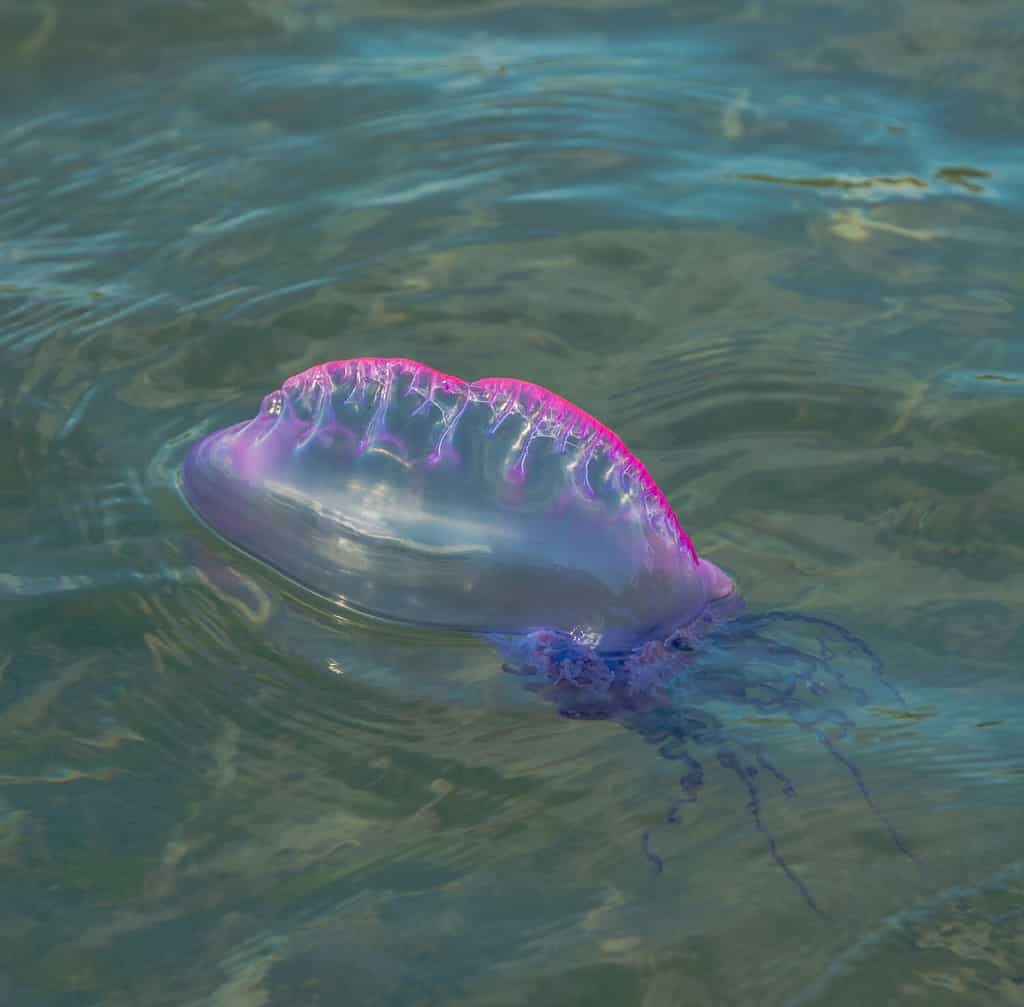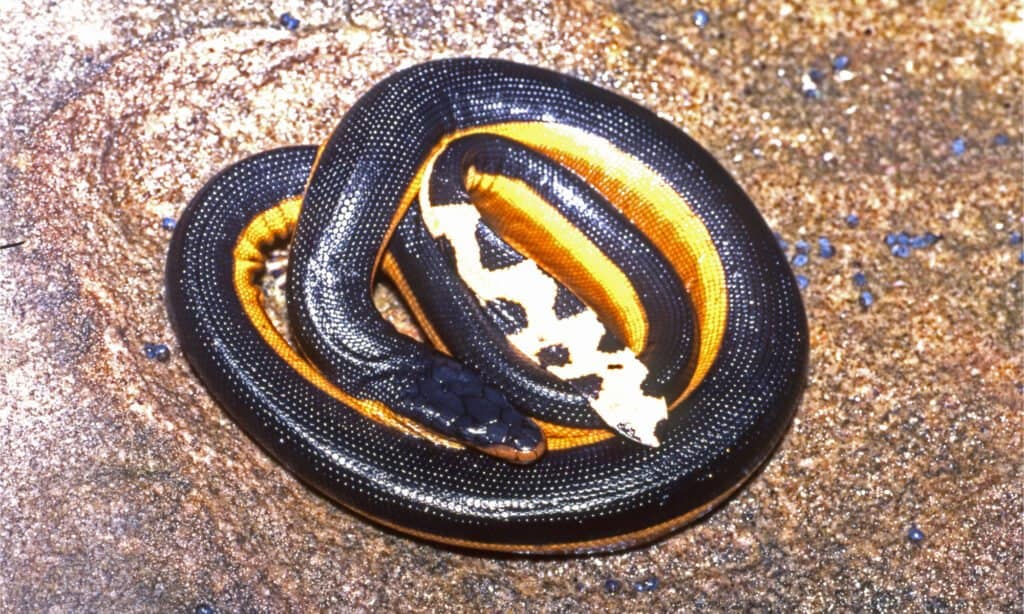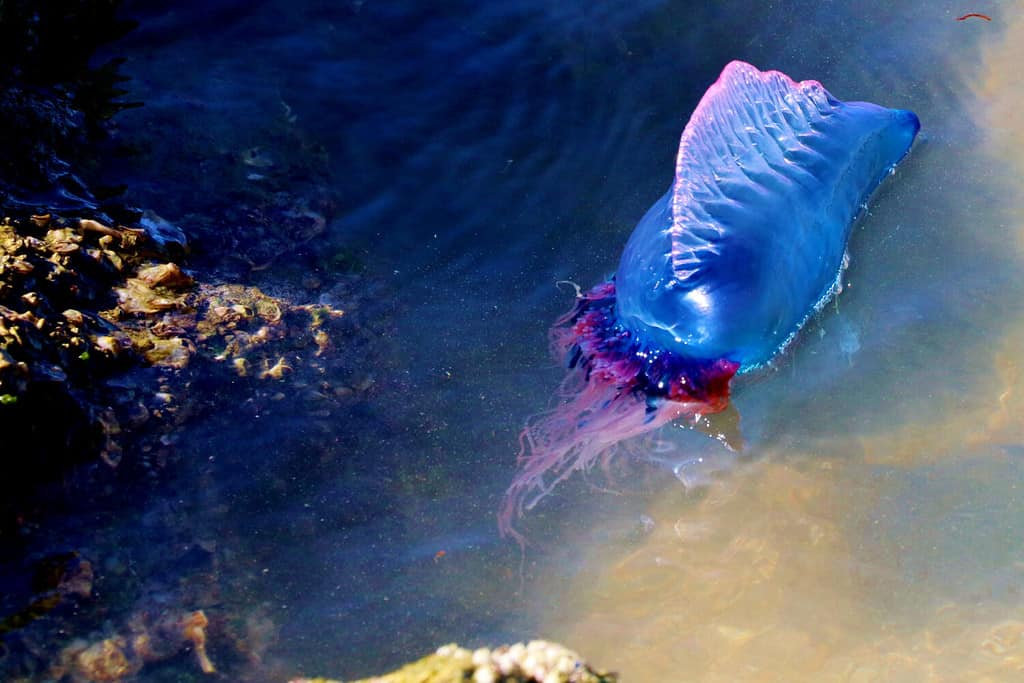The oceans are home to all manner of dangerous creatures. Sharks slink through the water in search of a meal and blue-ringed octopuses paralyze their prey before feeding. Sea snakes and Portuguese man-of-wars are deadly sea creatures that would probably never fight in the wild. After all, they can’t eat each other, and the snake is much faster. If these two animals fought, though, who would come out on top? Learn which animal wins in a battle between a sea snake vs. Portuguese man-of-war and how it would happen.
The yellow-bellied sea snake will be used to represent the sea snake in this fight.
Comparing a Sea Snake and a Portuguese Man-of-War

| Sea Snake | Portuguese Man-of-War | |
|---|---|---|
| Size | Weight: 1-4 pounds Length: 3 to 4 feet | Weight: about 1 pound Length: 30 to 100 feet long |
| Speed | – Up to 2.25 mph in bursts | – As fast as the water carries them with no ability to move on their own |
| Defenses | – Swimming speed – Ability to hide from others | – Their tentacles fire venomous nematocysts at a touch. |
| Offensive Capabilities | – Incredibly potent venom with an LD50 value of 0.067 mg/kg. – Deliver bites with small fangs that measure about 0.05 inches long. | – Has tentacles that trail behind them for up to 100 feet. – Uses stinging cells in tentacles to paralyze and kill fish and other small prey. |
| Predatory Behavior | – Actively hunts prey using stealth or an ambush to land a bite. | – Attacks anything that touches it. |
What Are 3 Key Differences Between a Sea Snake and a Portuguese Man-of-War?

The Portuguese man-of-war can measure 100 feet long.
©Broadbelt/Shutterstock.com
The biggest differences between a sea snake and a Portuguese man-of-war are their size, methods of movement, and hunting abilities. Sea snakes can weigh anywhere from 1 to 4 pounds and grow between 3 and 4 feet long. Moreover, they are active hunters that ambush their prey or sneak up on it and attack.
The Portuguese man-of-war is similar to a jellyfish in terms of its body type, but they are different species. They weigh about 1 pound and can grow anywhere between 30 and 100 feet long when counting their tentacles. They are passive predators that require animals to pass through their tentacles. Once something touches them, their nematocysts activate and paralyze the creature with venom while the tentacles guide the prey toward their digestive polyps.
These differences will greatly influence the way the fight occurs and the outcomes.
What Are the Key Factors in a Fight Between a Sea Snake and a Portuguese Man-of-War?

Yellow-bellied sea snakes are deadly hunters.
©Ken Griffiths/Shutterstock.com
The key factors in this fight will come down to offensive powers, defensive capabilities, and predatory behavior. However, it is important to flesh out more aspects of the fight to definitively state which creature would win. Our examination will compare five elements of the two sea creatures and see which has the advantage. Then, we’ll use that data to come up with the winner.
Sea Snake vs. Portuguese Man-of-War: Size
The Portuguese man-of-war is larger than the sea snake. At their lightest, both creatures weigh about 1 pound. However, the man-of-war is much longer, ranging anywhere from 30 to 100 feet long or more!
The Portuguese man-of-war has the advantage in size.
Sea Snake vs. Portuguese Man-of-War: Speed
The sea snake can swim at about 1 mph, but it can use a burst of speed to reach about 2.25 mph. Meanwhile, the Portuguese man-of-war does not propel itself. Rather, it goes where the current, tide, and wind take it.
The sea snake has the speed advantage in this fight.
Sea Snake vs. Portuguese Man-of-War: Defenses
The sea snake has limited speed it can use to escape from an adverse situation. However, humans have not observed any creatures preying upon them. They also have aposematism which shows they are a venomous species, and they have a foul taste that other animals do not want to consume. Furthermore, they can hide in underwater vegetation and coral, something they do while hunting.
The Portuguese man-of-war has a simpler defense, its long tentacles. If something so much as brushes against it, the creature’s nematocysts will send venomous thread into prey. The species has potent venom that can paralyze and kill small fish and crustaceans.
The Portuguese man-of-war has a highly effective, hard-to-break defense that requires some level of immunity to its venomous barbs to traverse. As a result, it is the winner of this defensive contest.
Sea Snake vs. Portuguese Man-of-War: Offensive Capabilities
The sea snake has an incredibly venomous bite. The creature’s venom has an LD50 value of 0.067 mg/kg, and each bite can yield up to 4 mg. Few terrestrial venomous snakes have venom that powerful. The snake has small fangs, so it cannot bite everything in the sea. Anything it does bite and inject its venom into would be in serious trouble. They use their venom to hunt prey, paralyzing and killing it.
Meanwhile, Portuguese man-of-wars have to wait for something to touch their tentacles to attack. When something brushes against them, their nematocysts activate, sending venomous barbs into their prey. Their venom paralyzes and kills small animals.
The sea snake has the advantage in this fight because its venom is incredibly potent and can be delivered on with purpose.
Sea Snake vs. Portuguese Man-of-War: Predatory Behavior
Sea snakes are active hunters. They lack the speed of many of their prey, so they sneak up on or ambush them. All it takes is one successful bite and their prey are all but done for. Meanwhile, a Portuguese man-of-war requires animals to approach them. They are not active predators since they cannot purposefully hunt prey.
Who Would Win in a Fight Between a Sea Snake and a Portuguese Man-of-War?

The sea snake would not get past the Portuguese man-of-war’s defenses.
©Laurel A Egan/Shutterstock.com
The Portuguese man-of-war would win a fight against a sea snake because the sea snake would not know to avoid the creature’s stinging tentacles. That being said, many problems exist with deciding which creature would win this fight.
The biggest issue is finding a location where the sea snake could bite the Portuguese man-of-war that would allow its venom to course through the creature’s body. Siphonophores are colonial organisms, so it may not be possible for the venom to impact these creatures the same way it would a fish.
So, if the sea snake decided to attack the Portuguese man-of-war, something it would not do because it cannot eat them, the snake may not be able to kill it like normal. Yet, it would probably run afoul of the creature’s tentacles and stinging cells before it could ever land a bite. The tentacles can range in length up to 100 feet long.
If the angry sea snake decided to bite a tentacle, it would probably be killed in the attempt. This fight would be interesting. However, the snake appears to lack a path to victory.
The photo featured at the top of this post is © Ken Griffiths/Shutterstock.com
Discover the "Monster" Snake 5X Bigger than an Anaconda
Every day A-Z Animals sends out some of the most incredible facts in the world from our free newsletter. Want to discover the 10 most beautiful snakes in the world, a "snake island" where you're never more than 3 feet from danger, or a "monster" snake 5X larger than an anaconda? Then sign up right now and you'll start receiving our daily newsletter absolutely free.
Thank you for reading! Have some feedback for us? Contact the AZ Animals editorial team.






